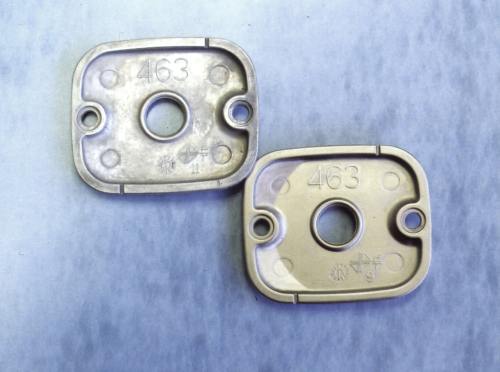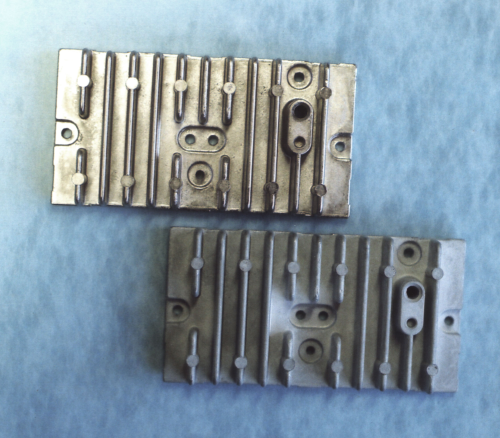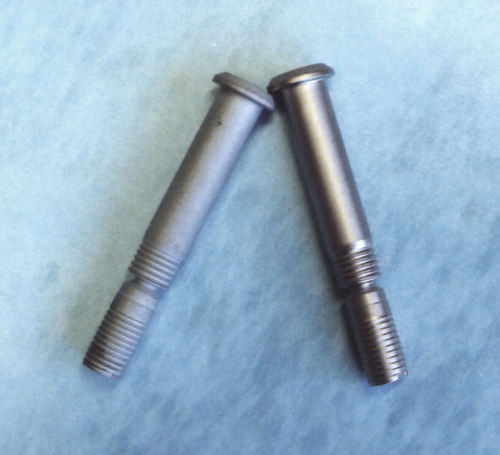


The process presented in this article eliminates the use of “zincates” and/or “stannates” and also negates a large portion of the extensive cleaning and deoxidation that is often required in the plating of titanium, aluminum, and magnesium alloys. The examples shown in this article involve the use of electroless nickel, as this is one of the more commonly plated materials on these metals and is often used as a base for the plating of other metals.
The lightness, strength, and high melting point of titanium, aluminum and various magnesium alloys make them quite desirable for use in the aerospace industry or many automotive applications. In many instances the metals need to be plated, but transition metals such as copper, chromium, nickel, etc., do not form good bonds with the light, non-transition elements.
For several decades, the plating of these metals has been accomplished by the initial application of a thin film of zinc and/or tin from what are known as zincate or stannate solutions.1 Simple zincate or stannate solutions are nothing more than solutions of zinc oxide or tin oxide in strong sodium hydroxide or potassium hydroxide, but for best results cyanide is generally added to the solutions.2 Other variations to the baths include mixing zincate with stannate and changing the pH and/or concentrations of the mixed solutions.3 In addition, copper is often plated out on these metals in order to smooth out rough areas or to improve the bonding characteristics of the metals being plated out. Due to cost considerations, zincate is by far the most widely used of these solutions.4
Cleaning and Deoxidation
With plating, more than just about any other type of metal processing, the most important aspect of the process is proper cleaning and deoxidation of the metal or metal alloy to be plated. Cleaning is the removal of surface oils and/or solid organic material, whereas deoxidation is the removal of unwanted inorganic compounds (oxides and hydroxides) that would interfere with the plating process. The exact cleaner selected will depend on the type of soil being removed and/or the metal or metal alloy being processed.
In general, a strong alkaline cleaner will give the best results on titanium, aluminum, or magnesium and their alloys. This is typically followed by a rinse in high-quality demineralized water—the rinse itself being where the actual cleaning takes place. The deoxidizer generally used on these metals and their alloys is a mineral acid (nitric, sulfuric, hydrofluoric, and/or hydrochloric) of low or high concentration, depending on the metal or alloy in question, followed once again by a rinse in high-quality demineralized water. In the past, these metals were in many cases deoxidized with chromic acid solutions or given chromate-based conversion coatings as a way of preventing the growth of metal oxides, and, thus, assisting in the application of the zincate and/or stannate solutions. Environmental concerns have now served to stop many of these procedures.
Magnesium
Due to the extreme reactivity of magnesium and its alloys, very little plating of the pure metal or its alloys takes place. Quite often the plating is over a copper strike applied to mitigate any oxidation that may have taken place on the surface of the metal during the cleaning and deoxidation processes or that will take place on the metal after it is plated. In addition, the copper strike acts to smooth over any scratches and/or pits on the surface of the metal.5 A commonly used procedure for the application of electroless nickel to a magnesium surface would involve the steps listed in Table 1.5 The new process being proposed would involve steps noted in Table 2.
| Step | Temperature | Duration |
| Alkaline soak cleaner | 180–200°F | 3–5 min |
| Rinse in demineralized water | ||
| Chromic acid or phosphoric acid pickle | Ambient | 30–60 sec |
| Rinse in demineralized water | ||
| Phosphoric acid–fluoride etch | Ambient | 1–2 min |
| Rinse in demineralized water | ||
| Fluoride-containing "zincate" | 155–160°F | 3–15 min |
| Rinse in demineralized water | ||
| Copper cyanide strike | 130–140°F | 6–8 min |
| Rinse in demineralized water | ||
| Electroless nickel plating bath to desired thickness |
| Step | Temperature | Duration |
| Alkaline soak cleaner | 180–200°F | 5–8 min |
| Rinse in demineralized water | ||
| Deoxidize in mild acid solution | Ambient | 15–30 sec |
| Rinse in demineralized water |
| Step | Temperature | Duration |
| Degreasing, if necessary | ||
| Strong alkaline soak cleaner | 180–200°F | 5–8 mins |
| Rinse in demineralized water |
To accomplish the newly proposed process, make the magnesium or magnesium alloy the cathode of an electrolytic cell containing a conductive emulsion of various polyamines and/or polyamides at about 15 amps per square foot for a few seconds, rinse in demineralized water, and go directly into the electroless nickel plating bath to the desired plating thickness (see Fig. 1). Subsequently rinse and then dry. The bonding surface generated by this process is at most about 400-nm thick and is self limiting in that leaving the part in the processing solution for longer periods will not cause any harm. Any excess polymer will simply go back into the processing solution to be used over again or be rinsed off.
Adhesion was excellent (baked at 375°F for one-half hour and quenched in cold water) using this process and subsequent plating of copper on the part was not a problem. In addition, it should be noted that rinsing, drying, and storing the processed part for several days before going into the electroless nickel bath is possible. One simply needs to soak the part in demineralized water for about half an hour to reactivate the bonding surface before going into the electroless nickel bath. If you only want to paint the part, the surface is excellent for painting.
Aluminum
Every aluminum alloy will have certain unique cleaning problems associated with it and, as such, it is not possible to give an all-encompassing cleaning process for all aluminum alloys. It can be stated that plating on aluminum will in almost every instance require a zincate or stannate process after cleaning and deoxidization to maintain a receptive surface.6
Due to the unusually high silicon content of most aluminum castings, they present a rather difficult surface to properly plate. These castings are generally deoxidized in fluoride-containing concentrated nitric acid solutions because nitric acid will prevent attack on the aluminum and allow the surface silicon to be removed by the fluoride. In the newly proposed process, a cleaned and deoxidized “383” cast alloy was cleaned and deoxidized, rinsed in demineralized water, and then made the anode in the polyamide and/or polyamine emulsion at 15 amps per square foot for a few seconds to generate the plating surface (in the case of aluminum it is sometimes more desirable to generate the plating surface by making the metal the anode). The casting was then rinsed and placed in the electroless nickel bath to the desired plating thickness, removed, rinsed, and then dried.
The casting showed no signs of adhesion failure when heated to 375°F for half an hour and then quenched in cold water. A freshly formed electroless nickel–plated surface could easily be plated with any one of a number of different metals. As in the case of magnesium, the parts may—if so desired—be rinsed, dried, and stored to be plated or painted at a later time. However, it is generally recommended that the parts be plated shortly after forming the bonding surface (see Fig. 2).
Titanium
Titanium is a rather noble metal that quickly forms a thin film of titanium dioxide when exposed to oxidizing conditions, making it very difficult to plate or paint. Quite a number of patents have been issued on the plating of titanium, most of which require extremely toxic and/or corrosive cleaning conditions,7 and in some cases a zincate solution will be used. The new process uses the non-toxic and relatively simple process noted in Table 3.
To accomplish this process, make the titanium the cathode in a electrolytic cell containing a conductive emulsion of various polyamines and/or polyamides at about 15 amps per square foot for a few seconds, rinse, and then go into your electroless nickel bath to the desired plating thickness (see Fig. 3). Once again, the process is self limiting in that leaving the part in the emulsion for a longer period of time will have no adverse effect, and the excess polymer will simply go back into the emulsion or be rinsed off.
This process exhibits excellent adhesion (baked at 375°F for one-half hour and quenched in cold water and/or bending 180° to check for loss of adhesion), and other metals could easily be plated on a freshly formed electroless nickel–plated surface. As with the other metals, the parts can be rinsed, dried, and stored for several days and then be reactivated for plating by soaking in demineralized water for half an hour if so desired. In addition, the surface can be coated due to excellent paint adhesion characteristics.
Conclusions
The electrolytic deposition of a thin film of various polyamides and/or polyamines on the surface of a magnesium, aluminum, or titanium surface and their alloys will allow the metals to be easily and quickly plated with other metals. This can be accomplished with far less difficulty than via the application of a thin film of zinc or tin by the use of a zincate or a stannate.
Notes
- Hewitson, E.H. (Eastman Kodak Co. ). U.S. Patent 1,627,900 (1927).
- Korplum, J. (Schering–Kahlbaum). U.S. Patent 2,142,564 (1939).
- Wernick, S., Pinner, R, Sheasby, P.G. The Surface Treatment and Finishing of Aluminum and its Alloys. Metals Park, OH: ASM International, 1987, pp. 1023–53.
- Wernick, S., Pinner, R, Sheasby, P.G. The Surface Treatment and Finishing of Aluminum and its Alloys. Metals Park, OH: ASM International, 1987, p. 1054.
- Dow Chemical Company, U.S.A., Inorganic Chemicals Dept. Operations in Magnesium Finishing, 1982.
- Wernick, S., Pinner, R, Sheasby, P.G. The Surface Treatment and Finishing of Aluminum and its Alloys. Metals Park, OH: ASM International, 1987, pp. 1055–8.
- Perform a Google search on “plating + onto + titanium + patents.”
Bio
Dr. John W. Bibber is the research and laboratory director at Sanchem, Inc. He holds a BS in chemistry from Shippensburg University, Shippensburg, Pa., and a PhD in inorganic chemistry from the University of Georgia, Athens, Ga. Bibber is the holder of U.S. and international patents on surface treatment processes for magnesium, aluminum, and other metals. He is also a member of AESF, an officer of ASTM, and a member of ACS.




